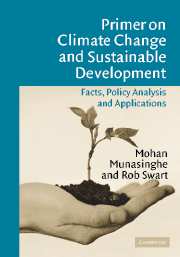Book contents
- Frontmatter
- Contents
- Foreword
- Preface
- 1 Climate change: scientific background and introduction
- 2 Future scenarios of development and climate change
- 3 Framework for making development more sustainable (MDMS): concepts and analytical tools
- 4 Interactions between climate and development
- 5 Adaptation to climate change: concepts, and linkages with sustainable development
- 6 Vulnerability, impacts, and adaptation by sectors and systems
- 7 Vulnerability, impacts, and adapation by geographic region
- 8 Mitigating climate change: concepts and linkages with sustainable development
- 9 Mitigation measures: technologies, practices, barriers, and policy instruments
- 10 Assessment of mitigation costs and benefits
- 11 Climate change and sustainable development: a synthesis
- Index
- References
10 - Assessment of mitigation costs and benefits
Published online by Cambridge University Press: 25 December 2009
- Frontmatter
- Contents
- Foreword
- Preface
- 1 Climate change: scientific background and introduction
- 2 Future scenarios of development and climate change
- 3 Framework for making development more sustainable (MDMS): concepts and analytical tools
- 4 Interactions between climate and development
- 5 Adaptation to climate change: concepts, and linkages with sustainable development
- 6 Vulnerability, impacts, and adaptation by sectors and systems
- 7 Vulnerability, impacts, and adapation by geographic region
- 8 Mitigating climate change: concepts and linkages with sustainable development
- 9 Mitigation measures: technologies, practices, barriers, and policy instruments
- 10 Assessment of mitigation costs and benefits
- 11 Climate change and sustainable development: a synthesis
- Index
- References
Summary
In Chapter 8, various approaches to the costing of mitigation options were discussed. In this chapter, we discuss how some of these approaches have been applied recently, and what their outcomes are. Section 10.1 sets out the various modelling techniques being used. In Section 10.2, we discuss costs of mitigation in various key greenhouse gas emitting sectors. In Section 10.3, the costs of mitigation at the national to global scale are explored, focusing on the costs of meeting the Kyoto Protocol targets. Section 10.4 addresses a number of key issues in costing analysis that should be taken into account when evaluating results, notably the existence of no-regrets options, the concept of double dividend, carbon leakage, spill-over effects, and avoided damage. Finally, Section 10.5 looks at the costs associated with meeting various stabilization targets for greenhouse gas emissions.
Costing models of greenhouse gas abatement
Evaluation of abatement strategies usually implies the usage of models. The modelling of climate mitigation strategies is complex, and a number of techniques have been applied including input–output models, macroeconomic models, computable general equilibrium models, and energy-sector-based models. Hybrid models also have been developed to provide more detail on the structure of the economy and the energy sector. The appropriate use of these models depends on the subject evaluated and the availability of data. Usually, different models give different, complementary, answers to different questions.
The costs of climate change policy have been assessed using various analytical approaches, including the following.
Input–output models describe the complex inter-relationships within the economic sector in its use of sets of simultaneous linear equations. This model is used when sectoral consequences of mitigation or adaptation options are of interest (Frankhauser & McCoy 1995).
[…]
- Type
- Chapter
- Information
- Primer on Climate Change and Sustainable DevelopmentFacts, Policy Analysis, and Applications, pp. 381 - 425Publisher: Cambridge University PressPrint publication year: 2005



